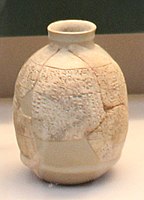| Gishakidu 𒄑𒊮𒆠𒄭 | |
|---|---|
| King of Umma | |
 Mace[1] of King Gishakidu giving the city of Umma's account of its long-running border dispute with Lagash. The vase redefines the frontier by recording the locations of stelae to the god Shara, as well as the distances between them. Circa 2400 BCE. From Umma, Iraq. Ref. 140889, British Museum, London.[2][3][4] Authorship lost, pre-Lugalzagesi Ummaite prince, could also be Il, king of Umma,[5] but now generally attributed to Gishakidu.[6] | |
| Reign | c. 2500 BC – 2400 BC |
| Predecessor | Il, king of Umma |
| Successor | Ukush |
| Spouse | Bara-irnun, daughter of Ur-Lumma, granddaughter of Enakalle. |
| Dynasty | 1st Dynasty of Umma |
| Father | Il, king of Umma, son of Eandamu, grandson of Enakalle. |
Gishakidu (𒄑𒊮𒆠𒄭 giš-ša3-ki-du10) was king of the Sumerian city-state of Umma and husband of queen Bara-irnun, circa 2400 BCE.[7] He was the son of Il, king of Umma, and his reign lasted at least 4 years.[8] He is particularly known from a gold votive plate by his queen, in which she describes her genealogy in great detail.[7] The inscription on the plate reads:
For (the god) Shara, lord of the E-mah: when Bara-irnun - wife of Gishakidu, king of Umma, daughter of Ur-Lumma, king of Umma, grand-daughter of Enakalle, king of Umma, daughter-in-law of Il, king of Umma - had made Shara resplendent and had built him a holy throne, for her life, to Shara, in the E-Mah, she offered (this ornament)."
The original royal line of Umma consisted in the filiation of Enakalle (possibly son of Ush) and his own son Ur-Lumma.[11][12] When Ur-Lumma died, presumably without a son but certainly with a daughter named Bara-irnum, the throne was handed over to Il, son of Eanandu (who had no regnal title) and grandson (or nephew) of Enakalle.[12][11] King Il was then succeeded by his own son Gishakidu.[12] Bara-irnum married her cousin Gishakidu, thus re-uniting both stands of the royal family by a marital alliance.[12][11]
Gishakidu is also known from a dedicatory inscription on a cylinder:
When Shara spoke to Enlil, the prayers gathered in his heart, and when he approached him, Gishakidu, the beloved shepherd of Shara, the one born .... a warrior Prince, the fear-inspiring leader of Sumer, who has no rival in all the foreign lands, the en-priest attached to the side of Ninura, counseled by Enki as by his own mother, the beloved friend of Ishtaran, the mighty governor of Enlil, the king selected by Inanna, at that time he constructed this boundary dyke.
A foundation inscription in his name is also known.[15]
-
Votive plate of Queen Bara-irnun of Umma, "wife of Gishakidu, king of Umma, daughter of Ur-Lumma, king of Umma, grand-daughter of Enakalle, king of Umma, daughter-in-law of Il, king of Umma", to God Shara, in gratitude for sparing her life.[7][16] Louvre Museum.[12]
-
Name of Gishakidu on the plaque (second column), and standard Sumero-Akkadian cuneiform (𒄑𒊮𒆠𒄭 giš-ša10-ki-du10)
-
The Gishakidu macehead, British Museum
- ^ Sanderson, David (January 2019). Museum "daftly" displayed warrior king's relic as an upside down vase (The Times).
- ^ "Vase of Lugalzagezi". British Museum. British Museum.
- ^ Full text, images in CDLI-Archival View.. Reconstructed as "Gishakidu".
- ^ "British Museum realises 'vase' is in fact an ancient mace-head displayed upside down". www.theartnewspaper.com. 7 January 2019.
- ^ Sollberger, Edmond (1959). "La frontière de Šara". Orientalia. 28 (4): 337. ISSN 0030-5367. JSTOR 43073422.
- ^ "An inscription formerly ascribed to Lugalzagesi can now be attributed to Geshshakidu (FAOS 5/2 Giššakidug 2 = RIME 1.12.6.2)." Sallaberger, Walther; Schrakamp, Ingo (January 2015). "Philological Data for a Historical Chronology of Mesopotamia in the 3rd Millennium": 78.
{{cite journal}}: Cite journal requires|journal=(help) - ^ a b c Art of the First Cities: The Third Millennium B.C. from the Mediterranean to the Indus. Metropolitan Museum of Art. 2003. p. 78. ISBN 978-1-58839-043-1.
- ^ Sallaberger, Walther; Schrakamp, Ingo (2015). Arcane III (PDF). BREPOLS. p. 78.
- ^ Art of the First Cities: The Third Millennium B.C. from the Mediterranean to the Indus. Metropolitan Museum of Art. 2003. p. 78. ISBN 978-1-58839-043-1.
- ^ Thomas, Ariane; Potts, Timothy (2020). Mesopotamia: Civilization Begins. Getty Publications. p. 108. ISBN 978-1-60606-649-2.
- ^ a b c Glassner, Jean-Jacques; Foster, Benjamin Benjamin Read (2005). Mesopotamian Chronicles. BRILL. pp. 104–105. ISBN 978-90-04-13084-5.
- ^ a b c d e Thureau-Dangin, F. (1937). "Une tablette en or provenant d'Umma". Revue d'Assyriologie et d'archéologie orientale. 34 (4): 177–182. ISSN 0373-6032. JSTOR 23284119.
- ^ "MS 2426 - The Schoyen Collection". www.schoyencollection.com.
- ^ Photograph and transliteration: "CDLI-Archival View". cdli.ucla.edu.
- ^ "CDLI-Archival View". cdli.ucla.edu.
- ^ Thomas, Ariane; Potts, Timothy (2020). Mesopotamia: Civilization Begins. Getty Publications. p. 108. ISBN 978-1-60606-649-2.

![Votive plate of Queen Bara-irnun of Umma, "wife of Gishakidu, king of Umma, daughter of Ur-Lumma, king of Umma, grand-daughter of Enakalle, king of Umma, daughter-in-law of Il, king of Umma", to God Shara, in gratitude for sparing her life.[7][16] Louvre Museum.[12]](http://upload.wikimedia.org/wikipedia/commons/thumb/0/05/Votive_plaque_of_a_beard-IMG_6857.JPG/133px-Votive_plaque_of_a_beard-IMG_6857.JPG)

